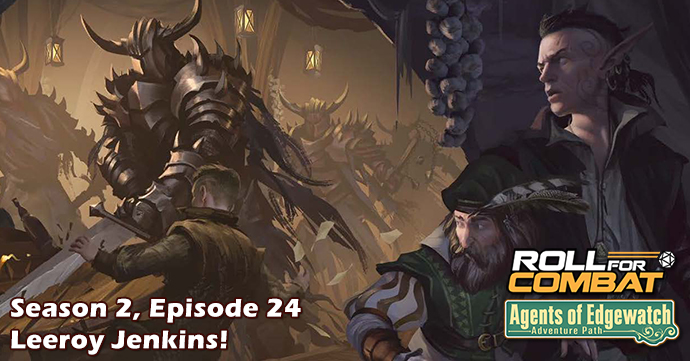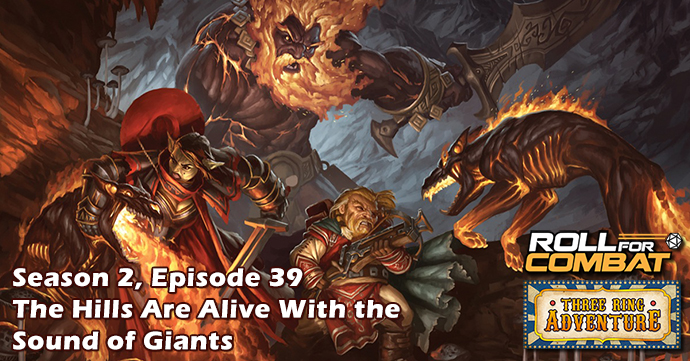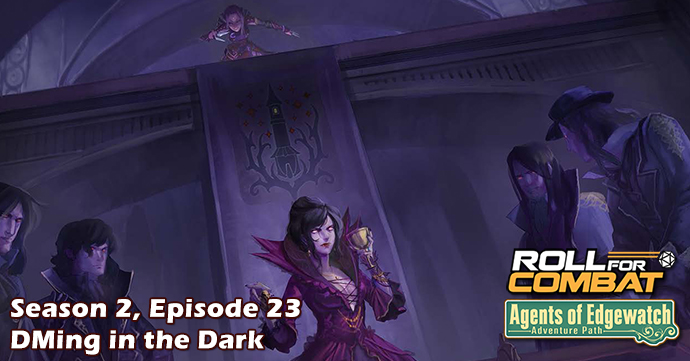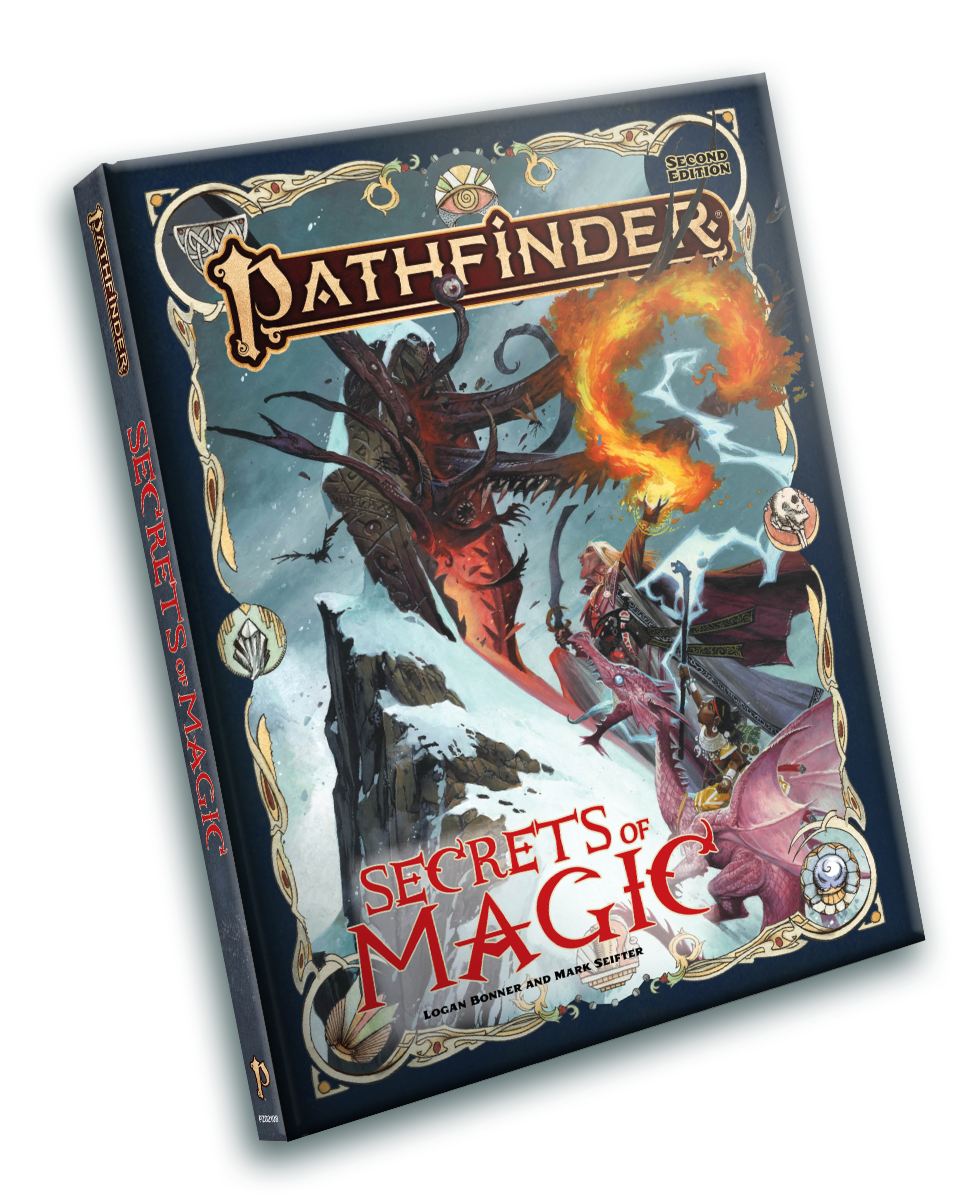Make sure to check out the Battlezoo Bestiary! Over 100 new monsters, the new Monster Parts System, play as a Dragon, the level 1-11 Jewel of the Indigo Isles Adventure Path, and more! Check it out now!
They say introspection is part of a healthy lifestyle, so let me start by dropping a bit of self-evaluation.
The Magus was my favorite class in Pathfinder First Edition, so I’ve been looking forward to Secrets Of Magic since the day I heard the Magus was going to be included. If I’m being totally honest, Secrets Of Magic could have been The Magus And Here’s 70-Some Blank Pages To Scribble In, and I probably still would have been pretty happy with it. Just being honest with all of you.
But Secrets of Magic – Paizo’s newest hardcover release – has ZERO pages to scribble in because it’s chock full of new magical toys for the Second Edition system, and that’s definitely an improvement over my idea. I can only really draw stick figures anyway. What strikes me at first glance is that it’s a book that both broadens and deepens the world of magic in Second Edition. What I mean is that it gives you more of what’s already there – new classes, new backgrounds, a whole lot of new spells, more magic items – but it’s also got a lot of content that expands the system in new directions, including a bunch of different variant rules you can play around with if you want your entire campaign setting to get a little weird.
But let’s start with the big news up front… the Magus and Summoner classes finally make their way to Second Edition. If you’ve played First Edition, you already know what these are likely to look like; but I’ll assume we have some people who skipped First Edition and may not know what to expect.

The Magus is a hybrid blend of warrior and arcane caster. At a Cliff’s Notes glance: you give up some of the spell slots you’d get as a full caster, but you get back armor, weapons, more hit points, and overall survivability. And, you’re your own walking, talking property rune because you channel magic through your weapon. Now… it’s true that up until now, you could get something in the ballpark of that by playing around with multiclass archetypes, but it’s kind of like that one meme – “Mom says we have the Magus at home”. You can create a character that both fights on the front lines and casts spells, but it’s missing the special sauce that holds it all together.
In this case, the “special sauce” of the Magus comes in the form of the Spellstrike class ability, which lets a Magus cast a spell and channel it into their weapon as part of a combined attack. Your first reaction might be “but wait, I only get one chance to hit and if I miss, my whole round is a waste! That sucks!”. But consider this – you get a one-action attack and a two-action spell as a two-action Spellstrike (so you’re immediately saving an action). So yes, there’s a lot more riding on each individual die roll, but overall the math and action economy are on your side. You also get “conflux spells” which are Magus specific spells that run off focus points (and therefore recharge after 10-minute rests), and you can obtain additional special abilities based on your specialization – there are builds for two-handed weapons, one-handed weapons, shields, ranged weapons, and staves.
If there’s a downside to this, it’s what you’d expect – you don’t have as many spell slots as a full caster, and your feats are all geared toward combat effectiveness, so good luck trying to make a “utility Magus” – you’re here to kill stuff, just with extra magic ‘splodeys. (Though now I’m sure SOMEONE will try to prove me wrong by building one.)

The Summoner? That’s more like half caster, half Pokemon trainer. You have a repertoire of spells, but most of your abilities come from forging a connection to an eidolon, a magical creature who serves as your sidekick and does most of your fighting for you. Unlike a normal summoning spell where the creature lasts for a few rounds and then disappears, your eidolon can be summoned as needed (though it’s a three-action ability) and sticks around as long as you need it to.
More importantly, the eidolon is a permanent creation that you design, and it grows as you level. When it comes to creating an eidolon, you start by choosing an origin (fey, beast, construct, demon, etc.) and choosing whether you want a warrior (STR) or scout (DEX) based build, but the specific look of your eidolon is whatever you choose it to be. So if you want your eidolon to physically manifest as, say, a golem made of Dippin’ Dots, you can do that. (And really, who WOULDN’T want that?)
The eidolon-summoner relationship admittedly starts out a little clunky – you basically have to share one turn between you when you first start. In fact, there’s a Level 1 feat called “Meld Into Eidolon” where you just acknowledge the early-level futility, use your eidolon as a battle suit, and hide behind its hit points. But as you level, you can take different feats that improve your eidolon, including feats that improve action efficiency. Though where’s the fun in that when you can also add far more interesting abilities? Spellcasting, different movement types, weapon proficiency… you know… in case the aforementioned Dippin’ Dots golem needs to wield a katana. (And again, I ask… who WOULDN’T want that?)
The Summoner does have a repertoire of spells, but again, fewer than a true caster. The good news is they can auto-heighten any spell they have, and they also have a secondary synergy with (wait for it) summoning spells: there are feats that let you take additional spell slots IF you use them on summon spells. But obviously, those feats will mean fewer feats to develop your eidolon, so it’s a trade-off one has to manage.

Now, in getting to the two new classes, I kinda skipped over Chapter 1… and I feel a little guilty doing that because there’s still good work and creativity that went into that as well. The first chapter starts with in-character world-building, with academic treatises written by various luminaries about the four traditions (arcane, primal, divine, occult), as well as a similar piece about magical “essences”. It then offers “The Eight Arches Of Incantation”, which summarizes the eight major magic fields – what makes something conjuration vs. illusion vs. transmutation? This one is meant to be in character as well, but written for a more general audience, so it’s closer to general GM info.
Then we have a few pages of magical backgrounds, both normal and rare. The “normal” backgrounds just expand backgrounds in a magical direction, as one can be an “academy dropout”, “magical merchant”, or a “plant whisperer”, but they’re still the standard “here’s some ability boosts and skills”. The RARE ones get pretty interesting because they offer special abilities (sometimes at a price). My favorite here is probably the “anti-magical” background where you’re resistant to magic: any spell cast on you (friend or foe) has to pass a DC3 flat check or it fails to affect you. So there’s a 10% chance that you shrug off an enemy mage’s fireball, but then again, the same could happen to that heal spell your ally casts on you.
Chapter 3, the largest by page count, gives us a WHOLE lot of new spells. Granted, this also includes the focus spells for the magus and summoner classes, as well as a few rituals, but that still leaves a LOT of new options for casters to take. I could sit here and list random cool spells I liked, but if there are a few recurring themes that keep popping up, they are battle forms and contingency spells.
Battle forms are spells that clarify the mechanics and expand the options for changing into another creature to fight – because hey, sometimes you’re either low on spell slots, or the enemy creature is resistant to magical damage and you just have to slap it around the old-fashioned way. The various battle form spells (aberrant form, angel form, OOZE form, and so on) let you change into that type of creature for a duration (usually a minute) and they specify all the stats and attacks you have available to you while in that form. (You also have a few options per spell, just so you can play around with different movement/damage/etc. options.) The druid’s Wild Shape ability did something like this for more common creatures; the new spells in Secrets of Magic expand that to the more esoteric options.

It should also be mentioned that most of these spells come with heightened versions where the creature gets bigger, you get more temporary hit points, and its attack hit harder. I’m not saying you should try being a gargantuan gelatinous cube, but… you should try being a gargantuan gelatinous cube.
Contingency spells are spells that you cast now, but take full effect later, when certain conditions are met. The basic concept already sort of exists with things like protective runes and magical traps, but Secrets of Magic expands on the concept. One of my favorites here is Instant Armor (and no, not just because I can sing John Lennon’s “Instant Karma” when casting it). It basically stores your armor in an extra-dimensional space, and it’s summoned to your body when you issue the activation command. Aside from having big Tony Stark energy, it’s got solid practical uses: imagine infiltrating an enemy’s stronghold where you have to get in through the front door politely – maybe a fancy-dress ball – but might get into a scrap once you’re in the building. (It’s not a contingency spell, but Juvenile Companion has a similar vibe – you can basically turn your animal companion into the cute non-threatening baby version of itself if you have to sneak it in somewhere.)
Oh, and hey, if you’ve got a spare thousand gold per level, and no morals about killing people, Secrets of Magic also offers the “Bathe In Blood” ritual which lets you either pause aging or grow younger. (Though if you critically fail the ritual, you die.) Golarion’s Ra’s al Ghul Lazarus Pits are open for business!
In Chapter 4, we tackle magical items. As with other parts of the book, there’s more of what we already know and love, and we also expand into some new territories.
Fulus are a hybrid of scroll and talisman, usually associated with the Tian Xia region. They’re paper charms affixed to weapons, armor, or sometimes locations. They mostly work as talismans, except since they’re designed as wards, they’re more commonly automated/defensive rather than activated by the user – the condition is met and the fulu activates.

A grimoire is a spellbook that has additional magical effects, usually an affinity for certain types of spells that makes those spells more effective. To use a specific example: let’s look at the Book of Lingering Blaze. If you cast a fire spell that was prepared from the book (but not, say, from a staff or wand), the flames are extra-hot and ignore up to 10 fire resistance.
Secrets of Magic also now lets you be your own rune with the addition of magical tattoos. (Including a skill feat to have your character become a magical tattoo artist.) There are only a few sample tattoos to introduce the concept, but I kind of liked the wave warding tattoo, which gives you a cast of air bubble if you ever find yourself in a spot where you can’t breathe.
Next up we have the concept of personal staves – it’s basically a system for designing your own staff and loading it with spells, including rules for making it more powerful and adding new spells as you level. Now, it’s not a total free-for-all – there has to be a uniting trait for all spells on the staff – so you can’t just make the Staff Of Spells That RAWK. But if you wanted to make a staff of water spells, or spells focused on movement abilities, or something like that… there’s now a way for you to do it.
Spell Catalysts are basically talismans for spells – single-use items that increase the effectiveness of a certain spell. For example, Firestarter Pellets add persistent fire damage to a fireball spell. Shimmering Dust added to glitterdust not only negates invisibility, but the affected creatures give off dim light. Now, here’s where Science Nerd Me points out that “catalysts” enable a reaction without themselves being altered or consumed, and then here’s where you should feel free to shove Science Nerd Me into a locker. (Hey, it’s kinda dark in here.)

Then there are Spellhearts. Think of them as permanent, and more powerful, versions of talismans. They generally have a passive effect if affixed to armor, and an active effect when affixed to a weapon; and in either case, activation casts a specific spell (generally, a once-per-day thing). So the lowest version of a Five-Feather Wreath contains the spell gale blast. Attaching it to armor gives a +1 to Acrobatics and negates 2 falling damage. But if you put it on a weapon, then when you cast the gale blast spell from the spellheart, you can take an action to fly five feet. (Not surprisingly, most spellhearts have multiple versions of different power levels – the highest level version of that five-feather wreath lets you fly 40 feet.)
Finally, at the end of this chapter, we still do have an expansion of more “traditional” magical items and consumables. There’s a lot of fun stuff here, but I’d just like to call out a couple of my favorites. First, one that has no combat use but could lead to fun roleplay is the Deck of Mischief – it’s a deck of playing cards that allows you to activate it to know where all the aces and face cards are, and make an illusory swap. However, the deck itself has a mind of its own, and if neglected or poorly maintained, may choose to malfunction of its own accord. More in the combat mindset, I’m a big fan of battlefield movement effects, so I love the Gloaming Shard. It’s a dagger that allows you to throw it tethered to a filament of your own shadow, and then teleport yourself to the location/enemy you threw it at (once per hour). Cool Nightcrawler vibes abound!
And now… we get to Chapter 5. Here’s where things get interesting… and maybe a little weird. It’s an entire chapter of variant rules if you want to play around with different magical concepts. Some of these apply concepts from one part of the game to another part of the game, some very much feel like homages to other fantasy settings, but some are just kinda doing their own thing. Keep in mind ALL of these are optional systems. You can use a few that sound cool, none at all… OK, trying to use all of them at the same time might end up kind of a mess, but there’s nothing to stop you from trying.

Now, I realize in advance this is going to get kinda laundry-list-y, but it seemed like presenting a little high-level information about each ruleset was better than either a) trying to jam it into one or two paragraphs and really telling you nothing or b) going deep-dive with examples on each one, and then you’re still reading this review when Guns And Gears comes out. I played around a little and this felt like the “right” amount of info.
- We start with cathartic magic – magic driven by emotion. It’s kind of like combining barbarian rage (but with more emotional flexibility) and spell casting. There’s a trigger event, which is usually a specific game mechanic. That puts the cathartic caster into catharsis, which gives them benefits for three rounds including a spell they only have access to while in that state. But at the end of the three rounds, they have an “emotional fallout” that confers some sort of negative status. All of this is then cleared by “settling your emotions” over a ten-minute rest.
- Elementalism builds around the four traditional elements of water, earth, fire, and air (FLAMEO, HOTMAN!). We get some formal feats for druids and monks to flesh out the parts of the elemental spectrum that were a little weak in their previous rules, and then we get the elementalist class archetype that allows ANY character to become an expert in the traditional forces. Of course, if you’re a caster, you have to give up your normal spell list and choose ONLY from the elementalist spell list, but you get other benefits in trade.
- Flexible preparation is a system for adjusting the prepared caster classes if you want to let everyone just cast spells spontaneously like a sorcerer does. The gist… you get a few fewer spell slots, but you can cast any spell you know in a slot. There’s also a single-feat archetype that makes the wheels on the bus go ‘round.
- Geomancy is another archetype; one that feels like it brings the idea of rangers’ “favored terrain” to the casting world. You basically “attune” to the terrain you’re in, at which point you can get movement bonuses, draw power from the land to heal, things like that.
- Ley lines play around with the idea that there are invisible streams of magic in the air around us. This ruleset lets a caster tap into those lines and use them to enhance their magic… or they might blow up if they fail their save. But if they succeed, they can do things like add persistent damage to spells, perform some of the metamagic feats like adding reach, and so on.

- Pervasive magic… this is the “what if EVERYBODY had access to at least a little bit of magic?” ruleset. (See also: Piers Anthony’s Xanth setting without all the perviness or the Black Cloveranime without Asta proclaiming someone or something cool every five minutes.) The town guards have magic missile! The barmaid can knock out unruly patrons with sleep! It’s ANARCHY! But if you want to go there, Paizo has you covered. You’ve got rules for assigning additional spells based on the entity’s level (friend OR foe… those kobolds you’re fighting get magic too!), a few feats to make the system work, and interestingly, a section that reviews the map of the Inner Sea and recommends magical hot spots where you could implement this if you were so inclined.
- Shadow Magic provides us with an archetype for the gothiest caster you could ever hope to create. You basically sacrifice a little piece of your soul to get access to all sorts of neat shadow spells, but you also completely lose the ability to cast spells dealing with light. Bad poetry and trips to Hot Topic may or may also be involved. (OK, I’m deflecting… I want to roll one.)
- Soul Seeds border on something out of a JRPG… not an insult, just an observation. They’re relic-level items you harvest from powerful enemies, that provide a soul gift: a new ability. Obvious example: kill a red dragon, and its soul seed grants the ability to breathe fire.
- Soulforged armaments are armor and weapons where you create a special supernatural bond based on an oath – “seek justice”, “protect the downtrodden”, even something more specific like “rid the world of undead”. The benefit of the bond is that it grants the gear additional magical powers (including the ability to store it extradimensionally and summon it when needed); the danger is that if you don’t honor whatever oath you made to the gear, it can become corrupted and lose effectiveness until the corruption is cleansed. So if you promised to help the downtrodden and then go to work as a mercenary for a rich nobleman, you might have a problem. Note that there is still an underlying physical weapon that can be upgraded, replaced, or engraved with runes, so you’re not locked into your Level 1 Pointy Stick forever.
- Runelords? These guys are pretty well-known within the lore of Pathfinder. They were mostly bad guys in First Edition – a society of esoteric mages who were corrupted by sin — but here in Second Edition, a Thassilonian city from 10,000 years just plunked itself down in the modern world, and half the Thassilonians are trying to move on and return to the Runelords’ more noble origins. Which, I suppose, opens up the possibility of Good Guy Runelords. Among their interesting little tricks are fighting with polearms – something you don’t usually expect of wizards – and embedding aeon stones in their skin. (There’s a Bedazzler joke begging to be made, but I’m gonna leave that for someone else.) I particularly like that they can make a magic staff the shaft of a polearm, thereby having access to a melee weapon AND the spells on the staff… that’s pretty neat.
- True Names embrace the idea that most entities (particularly the evil ones) have multiple names, and learning a creature’s true name gives you power over it. This ruleset gives you feats and spells for identifying a creature’s true name and exploiting that either through compelling (making it perform actions) and invoking (doing more damage). You can also make an amulet that makes the invoke effect against that creature permanent.
- Lastly, we have Wellspring Magic and the Wellspring Mage archetype, which in some ways saves the best for last. The general idea of wellspring magic plays around with unstable magical ability, and it kicks in every time you roll initiative or are in a high-stress situation. If things go well, you recover spell slots without having to rest; if things go badly, you generate a “wellspring surge” which is a random effect – could create a protective shield, could allow everyone to read your thoughts, could just go boom. The min-maxer in me would NEVER play a character with such random outcomes, but the STORIES such a character would create… “yeah, we almost had the dragon beat, and then Zolgar went and HEALED it”.
And that… in a larger-than-normal nutshell… is Secrets of Magic. As you can see, there’s a LOT of stuff in there, and some of it takes the game in unexpected directions. You certainly can’t go wrong with two new classes and a bunch of new spells; adding more of what people already love can’t really go wrong. As far as the variant rules, I feel like the sheer variety is what impresses me – sure, nobody’s going to want to use ALL of them, but it’s hard to imagine any Second Edition player looking at those rules and not finding at least a couple that sound fun and worth incorporating into their game. (Me, it’s soulforged weapons and the wellspring mage. And OK, might want to roll up a Runelord.) In short, it does feel like they’ve cast their nets in enough different directions that there’s something for everyone. So if you want your Second Edition campaign to get a little weirder and paint with bolder colors, definitely add Secrets of Magic to your gaming library.
Make sure to read Jason’s review of the Pathfinder Second Edition Core Rulebook, as well as his review of the Pathfinder Advanced Player’s Guide, Pathfinder Lost Omens: Legends, Pathfinder World Guide, Character Guide, Gods & Magic, The Mwangi Expanse, Gamemastery Guide, Bestiary 2, and Bestiary 3.
If you enjoyed this review make sure to check out our Pathfinder Adventure Path: Agents of Edgewatch Podcast and our Pathfinder Adventure Path: Three Ring Adventure.
















